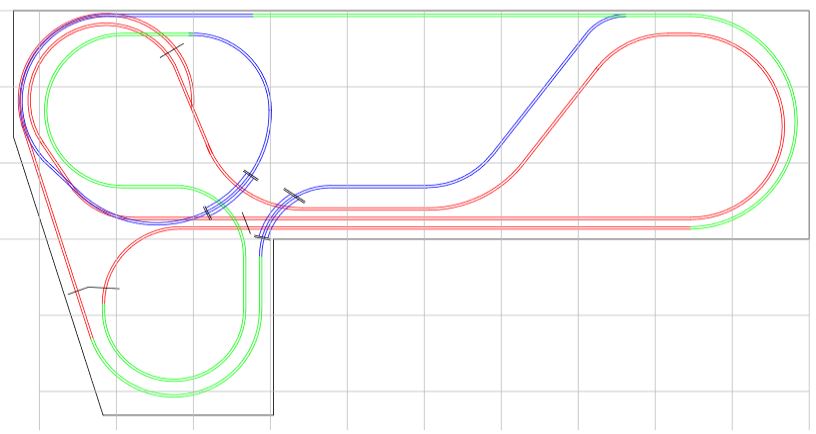Everything on model trains, model railroads, model railways, locomotives, model train layouts, scenery, wiring, DCC and more. Enjoy the world's best hobby... model railroading!
Replacing Existing Track on an Older Layout
Steve sent in this question and diagram:
“I am completing a layout started by my father over 50 years ago. He had used Atlas brass code 80 (black ties) flex track on cork roadbed, all nailed down, soldered connections. My redo will model mid-century passenger trains from California through the Rocky Mountains. I would like to replace it with a nickel silver track. The total run length is about 80′ (not counting yards). I have 34′ of Atlas code 55 & 35′ of Peco code 80, both brown tie flex track. Not enough of either to complete the changeover. I like the look of the Atlas 55, but code 80 is stiffer, but ties are farther apart. Which would have more options for matching turnouts?”
 The red is lower track, green is transition grade, blue is upper level. N scale, each square is 1’ x 1’.
The red is lower track, green is transition grade, blue is upper level. N scale, each square is 1’ x 1’.
If you have a question you would like published, then send it in using one of the ASK A QUESTION links. If you want to supply a supporting photo or drawing, then simply mention that when submitting your question. The Blog Moderator will let you know how to email it.















Well that’s really a question that’s best answered yourself after working out how many of what type of turnout you need, and then looking online. Both Atlas and Peco have a number of n scale turnouts in both code 55 and 80
If you are going to ballast the track, the appearance of spacing of the ties will not be so obvious as it appears now when comparing the track.
But unless you are going with all new locomotives and rolling stock, you need something that the 50 year old equipment can run on, and that is probably going to be the larger code 80 rail. So if you are using the old equipment, make sure it runs on the rail you now have before doing anything else.
Have fun!
Thanks
The Peco track sleeper (tie) spacing is a little close for prototypical appearance sor setting the ties a little closer/further to match the Atlas track is no biggy. In Oz many rivett counters cut the plastic between the ties and do this.
As for pointwork, the Peco Electrofrog is a great piece of kit and comes in three sizes (Long, medium and short), and a fully curve version.
Brass track is not just last years, it is a pain to keep clean or to weather so giving it the heave ho is essential.
Many prototype railroads use smaller code rails for sidings and less used trackage. If it were me, I’d go with code 80 for the mainline and code 55 for the spurs and sidings. As Geoff said, make sure that your equipment’s trucks can run reliably on the smaller code 55 track. You might have to change wheelsets on some cars.
As for the different color ties, you can always paint or weather the track which, when ballasted, could hide the differences.